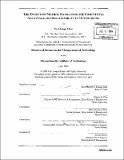The evolution matrix : navigating the competitive advantage and sustainability of outsourcing
Author(s)
Chen, Carl Joseph, 1970-
DownloadFull printable version (8.304Mb)
Alternative title
Navigating the competitive advantage and sustainability of outsourcing
Other Contributors
Massachusetts Institute of Technology. Management of Technology Program.
Advisor
Charles H. Fine.
Terms of use
Metadata
Show full item recordAbstract
The thesis addresses whether there is competitive advantage to outsourcing and whether outsourcing is sustainable. The reason, outsourcing (to foreign countries) has become an acerbic topic because the breadth of its impact has now reached all strata of society-from blue-collar to white-collar. Our answer is based upon the pooling of several analytical tools: Ricardian comparative advantage, game theory, system dynamics, Clockspeed and a new holistic framework developed for this topic, the Evolution Matrix. Together these tools represent an Evolution Trajectory that is representative of progress, which for the purpose of this thesis is interpreted as advances in technology and globalization. Thus, these tools are applied from a perspective that is grounded deep in history. In doing so we learn that outsourcing is a part of the trajectory theme. A part of this trajectory theme is the global turnkey production network for the electronics industry. Its growth, abroad, and utilization by American electronics companies have a double-edged nature. This network has been a savior and potential source of competition. Our conclusion, outsourcing is a tactical tool. For companies, outsourcing may not aid a firm in its core competency quest. The competitive advantage of outsourcing is fleeting at best and outsourcing is sustainable only over the short-term. However, despite these risks, it will not fade away because of technology's progress. The issue then is how best to navigate the outsourcing debate. To do this the manager must plot his company's location and chart its trajectory within the competitive landscape. This is what the Evolution Matrix was developed for.
Description
Thesis (S.M.M.O.T.)--Massachusetts Institute of Technology, Sloan School of Management, Management of Technology Program, 2004. Includes bibliographical references (leaves 147-161).
Date issued
2004Department
Management of Technology Program.; Sloan School of ManagementPublisher
Massachusetts Institute of Technology
Keywords
Management of Technology Program.